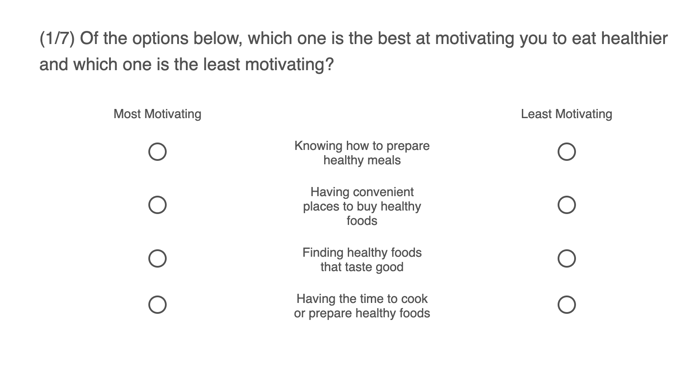MaxDiff, also known as "best-worst scaling," is hands down one of the coolest quantitative research techniques out there. At its core, MaxDiff is all about measuring the relative importance of multiple items within a group.
Think of MaxDiff as a ranking exercise on steroids. Instead of just ranking items from best to worst, attributes are randomly grouped together, 3-5 at a time. You're put on the spot to pick the best and worst in each set. It's like a game of choosing your favorites and least favorites, over and over again.
Now, you might think it sounds complex, but MaxDiff is actually very simple for respondents to get the hang of. They see a few attributes on the screen, weigh them up, and pick their top and bottom choices. This method greatly reduces response bias, giving us more precise data to work with. Cool, right?

Example of a MaxDiff matrix for a public health campaign.
Analyzing MaxDiff Data
The initial data output is called "preference of share," which shows how much of the market values each attribute the most. Digging deeper, we then analyze our MaxDiff data using statistical models like latent class analysis and TURF analysis to deliver rich, targeted insights for our clients.
Latent class analysis uncovers data trends and identifies consumer segments, empowering our clients to tailor their messaging to different audiences. For instance, males aged 25-44 in rural areas may connect with a specific attribute mix, while females aged 18-34 in suburban regions may resonate with a different mix.
TURF analysis, short for Total Unduplicated Reach and Frequency, pinpoints the messaging or attribute mix that resonates with the largest share of the market. For example, by examining the top two attributes for each respondent, we suggest our clients use 3-5 messages to expand their reach, showing how their overall reach grows with each additional message or attribute.

Example TURF analysis output for a public health campaign.
Using MaxDiff for Advertising Campaigns
MaxDiff is a game-changer for crafting advertising strategies or campaigns. We leverage it to pinpoint the messages that will be most effective and prompt consumers to take action.
Picture this: a client presents us with 8 potential messages for their upcoming campaign. They only plan to use 2-3 of them though and need to narrow them down to find the ones that will be the most effective. Using our MaxDiff model, we can reveal the top-performing messages overall, the messages that resonate best with specific market segments, and the ideal mix to capture the largest share of their target market.
This approach saves our ad agency partners time and money, making them look like rockstars to their end clients.
Using MaxDiff in Public Health Campaigns
Similar to the advertising example above, we use MaxDiff in public health research to spark positive behavior change. Whether we're nudging folks to up their exercise game, be kinder souls, or dial down on unhealthy habits like smoking or driving buzzed, MaxDiff is our superhero showing us the way.
Let’s imagine we’re trying to urge folks to eat healthier. We may have several ideas on how to motivate them, but with MaxDiff, we can pinpoint what people really need to enable them to make healthy choices. In the TURF analysis example above, we can see that the top three factors that will motivate people to eat healthier are:
- Greater willpower to say no to unhealthy foods
- Finding healthy meals that their kids or family will eat
- Having the time to cook or prepare healthy meals
Using this data, we could recommend that our client produce a campaign showing people how to have greater willpower when choosing what to eat and providing ideas and recipes for family/kid-friendly healthy meals that are quick and easy to prepare. This mix would resonate well with 73% of the market. If they expanded their campaign to also include finding healthy options on the menu when dining out, the reach would extend to 85% of the market!
Whether we’re trying to drive new business for our clients or transform people’s lives through positive behavior change, MaxDiff reveals the insights needed to accomplish the goal. It's our trusty tool that's powered numerous advertising and public health campaigns across Oklahoma and beyond!
Related Content:
Posted by Stewart

Stewart is passionate about all things research. Designing studies, analyzing data, and moderating interviews - Stew does it all. Outside of research, he enjoys spending time with his wife and kids and trying new recipes on the grill.



